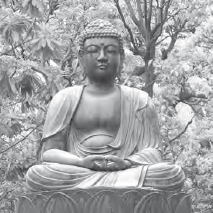New PhilosophyBuddhism and Confucianism |
What is Buddhism? |
Buddhism was founded in India by Siddhartha Gautama. The majority of Indian scholars place his lifespan as c. 563–c. 483 B.C.E. Indian Buddhism divided into Theravada, or Hinayana or “Lesser Vehicle,” and Mahayana, or “Greater Vehicle.” Indian Buddhism was no longer a vibrant religion in India after the thirteenth century, but it had by then spread geographically. Theravada Buddhism is practiced in Thailand, Laos, Cambodia, and Sri Lanka. Mahayana Buddhism is practiced in China, Japan, Nepal, and the United States. Tibetan Buddhism, in addition to including the Greater and Lesser Vehicles, has a form known as Vairayana. All of the three vehicles are practiced in Himalayan parts of Mongolia, Northeastern China, and Russia.
Zen Buddhism is practiced in Japan as a kind of meditation called “zazen” that repudiates texts (even though there is a written tradition) and focuses on unmediated direct experience. Zen originated in India and emerged in China in the seventh century C.E., from which it spread to Vietnam, Korea, and Japan. Zen includes Yogācāra, which is a form of philosophical idealism that uses yoga exercises to achieve disbelief in the existence of physical objects.

